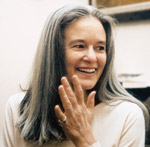
Photo by Catherine Mauger
Olds was poet laureate of New York from 1998 to 2000. Her many honors include the T.S. Eliot Prize, the National Book Critics Circle Award, and the Pulitzer Prize. Her most recent collection, Stag’s Leap, came out in 2012.
What started you writing poetry?
I started writing poems as a child and teenager. I think what made me start was the desire to “sing,” to make up word songs, to play with words and rhymes, to tell a story.
Your collection Stag’s Leap won both the T.S Eliot Prize and the Pulitzer Prize last year. These intimate poems chronicle the dissolution of a marriage of 32 years after the husband abruptly leaves his wife for another woman. Can you speak about the title? Stag’s Leap evokes such exuberance and vitality in contrast with the many painful images throughout the book.
The title poem is named after a wine, in fact after a wine label, which has a picture of a leaping deer on it. The poem is a portrait of a departing or escaping creature. I’m glad if it has vitality! I guess my hope would be that the images in the book, painful or not, would have their own vitality and give the reader pleasure.
What was the process like assembling the poems as a whole?
First I assembled all the poems I’d written on the subject, over 10 years, which I’d liked well enough to type up and revise. (Which was a fraction of the number I’d written on the subject.) Then I tried to narrow the group down to what I thought were the best of them, and then I looked for how they seemed to organize themselves. I did this on the dining room floor! Changing the order over and over until it seemed right.
When people describe your work, they inevitably talk about its autobiographical aspects. In fact, Stag’s Leap can be found under “Biographies and Memoirs” on Amazon, which seems unusual for a book of poetry. Do you mind being considered a distinctly autobiographical poet?
What interests me most about the poems I read (and write) are things like the images, the music (rhyme and meter), and how the sentence and the line interconnect with each other in the poem. Over the years, I haven’t talked much about biographies and memoirs — though I love reading them; what has interested me most about poems is the art of them — what each one is doing, and how.
You’ve said that you want a poem to be useful above all else. Can you talk about this a bit more?
I think the arts exist because they are useful — essential to our species. I think it’s part of being human, to make art and need art. For the pleasure of it, and for whatever knowledge we get out of it. Reading each other helps us imagine each other. And empathy seems like something we are in great need of, as a species, in order to survive.
Although your work is commonly described as free verse, you’ve mentioned that your next book will concentrate on odes. Is it liberating or particularly challenging to work in a more formal structure?
I have not, over the years, tried to write in a particular form, but when I look at my poems, I see that they have been written in four-beat lines (four strong accents, however many syllables the line has), with few end-stopped lines, and a lot of enjambment (the sentence pouring over the end of one line into the next). So I see myself as a formal poet: four-beat lines, and enjambment, and internal — rather than end-stopped — rhyme being my form. (I don’t see myself as writing “free verse.”)
As for the odes I’ve been writing, they may not be odes at all — I’ve been afraid to look up ode in case it’s an illusion of mind that I’ve been writing them: poems addressed to objects or general categories of objects or beings (“Ode to the Hymen,” “Douche-Bag Ode”).
Do you have a reader in mind when you write?
I’m not sure what I have in mind while I’m writing a poem — I think I’m trying to have not much in mind! I’m trying to float above or below my mind — my own radar — and let the poem “write itself” — emerge intact from wherever in my subconscious it has been forming! A poem needs a lot of freedom, to maintain/create its own “breath” and life. I think if I were “aiming” it in some way, a poem would not have enough free will to seem alive. Having said that about the minutes of the first composition of a poem, I have to add that the thought of anyone reading a poem of mine feels like a great blessing and good fortune!
Interview by Joy Biles